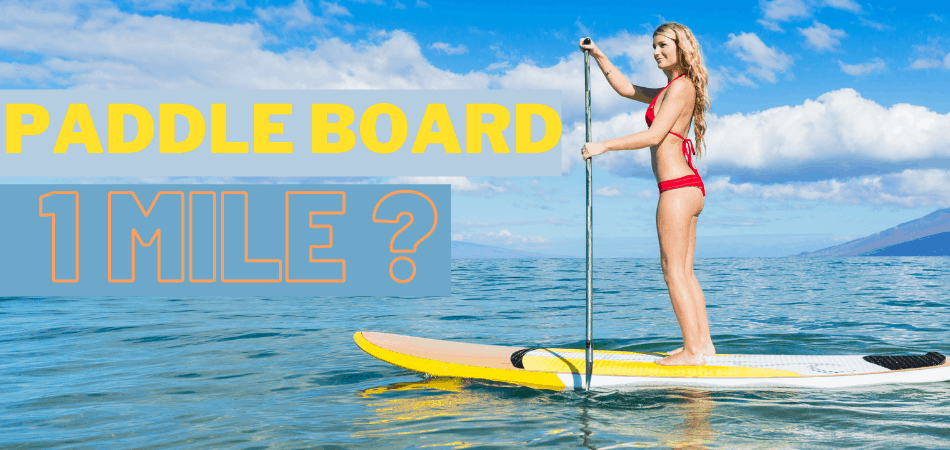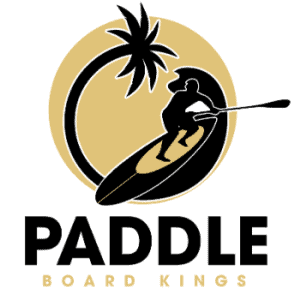
When I first started paddle boarding I did it to focus on a fun full body workout. I learned quickly that you can get tired quickly especially when you first start out. It is a good idea to know how far you can go and how long it will take you before becoming too confident too quickly.
It’s so easy to get stuck trying to compose the perfect article but it’s more important to simply get something out there. Your writing style will emerge and evolve as you write more.
So, How long does it take to paddle board 1 mile? It takes the average paddle boarder 30 minutes to paddle board 1 mile. This is calculated based on the overall average speed which is 2-3 Miles Per Hour.
I know what it is like to be out in the open water and starting to wonder how far can I actually go and how fast. It can be really difficult to tell how long it will personally take you to go 1 mile because every person and situation can be very different. Read on to learn more in depth what I am talking about.
How Long It Will Take To Go A Mile On A Paddle Board
So, here are some key factors that will play a role
Fitness And Experience level:
Fitness level will directly affect your speed. The more agile, athletic and overall fit you are will only help you to be able to cover a mile faster based on your physical capabilities and balance.
Keep in mind just because you are in good shape and maybe used to doing many sports or other outdoor activities don’t expect to go soaring across the water when you first start out. Being fit does help but paddle boarding is not just the same as running there are other skills required.
Speed will come with time, so going a mile at first is going to take you a lot longer than an experienced paddler.
Which brings me to why seasoned paddlers will cover a mile a lot faster than someone who is new to paddle boarding. With any other workout, the more you get your body used to it, the further you will go. The same goes for paddle boarding. When you get better with paddle boarding, you will find yourself going further every time you do it.
Going a mile can take a lot longer for someone who does not have enough experience because of many different factors.
One factor is their paddling technique. When you are first starting, it will take a few tries to figure out the right paddling technique for your body and board. This means that there are going to be a few trial-and-error rounds on your board before you really get good at it.
We all go through this when first starting, but of course this does slow you down. Though many may catch on quickly, no one is going to just hop on a board and do it perfectly the first time they try. (Including experienced athletes)
Another factor is balance. Paddle boarding is truly a test of balance and core strength. Like any other balance test, sometimes you will fall. That’s almost inevitable when it comes to paddle boarding.
Learning to move your arms without shifting your entire body can be a difficult challenge for anyone, and no one knows that better than a paddle boarder. So, how does balance play a factor in distance traveled. Well, when you lose your balance and fall, you will need to take the time to get back up on your board. This can make achieving a mile take a lot longer.
There are also a lot of different methods of paddle boarding that will also affect how fast you cover a mile. More distance will be covered with paddle board racing rather than just a casual boarding experience. Some people also like to stop, take a break and even many do yoga exercises on their board as well, which would not count toward distance but certainly gives you a great workout.
| EXPERIENCE | SPEED | 1 MILE TIME |
| Beginner | 2-3MPH | 30 Minutes (AVERAGE) to 20 Minutes |
| Intermediate | 3-4MPH | 20 Minutes- 15 Minutes |
| Experienced | 4-5MPH | 15 Minutes-12 Minutes |
| Professional | 5-7MPH | 12 Minutes-8.5 Minutes |
Types of paddle boards Will Make A Big Difference In SUP Speed And Distance
Paddle boards come in a few different varieties depending on your specific needs. For example, they make separate boards for kids that are a lot easier to control and lighter than adult boards. But for adults there are different varieties to choose from.
All Rounders:
These boards are best for beginners, but many experienced paddlers love them too. They tend to be wider than other boards which makes it easier for you to balance. These won’t move you quite as fast as other board types, but they will help you stay balanced which could shorten your mile time and help assist you from falling. These boards are great for flat water and fishing.
Family style:
Family boards are made for the whole family to use. The wide nose and stable tail make it easier for anyone to balance on these boards. These boards are going to be slower than all rounders due to their size and design, however they are great for bringing your dog or kids along for the ride with you.
This is another option that is highly recommended for beginners and makes it easier to keep your balance, but you won’t be able to move as quickly as some other boards that are meant to go faster but it is the perfect beginner board.
Racing/Touring:
These boards are longer and thinner than family style and all rounder boards. This means that it will be more difficult to balance on these boards, but the long, thin design will allow paddlers to move a lot faster. So, if this is your chosen board, it will definitely take less time to cover a mile as long as you have the experience to handle this board. These boards also tend to move straighter than other boards because they are not as wide. So, they are easier to control if you can keep your balance.
Inflatable:
Many paddlers like to use inflatable boards for limited space, easy transportation, any walking or hiking and whitewater paddling. These are highly recommended for anyone using their board around rocks or if they are expecting their board to get a little beat up when using.
Because they are inflated, they are a little more comfortable than original boards but inflatable boards will not move as fast as solid boards. So if this is the board you choose, it will take longer for you to complete a mile if that is your goal.
Sizes Of Paddle Boards
There are many different sizes to choose from when selecting your board. Generally, the thinner and longer your board, the faster you can go. There are a few factors that can determine how fast you will be able to go when it comes to paddle board styles:
- Length: The board length is an important factor. Short boards will be the slowest, but also will be the easiest to control. Medium length boards will be able to go a little faster. This is the size of most all rounders. Finally, longboards are the fastest boards available because they are built with a sleeker design for speed.
- Width: Width is a very important factor for speed. While wider boards make balance easier, they also slow you down. So, when considering the width of your board, keep in mind that balance will come with experience, but a board that is too wide for you can be difficult to paddle and will slow you down. Still a great beginner board and great to practice on especially when you are not focused on speed at first.
- Thickness: Choosing the thickness of your board will determine how much weight it can support. If a thin person is using a thick board, then they will find it difficult to control and manage speed. This isn’t as simple as saying that thinner boards go faster because if you get a board that is too thin, then there could be a weight capacity issue.
This really comes down to testing out different boards over time and getting more and more experience and better techniques. Once you are comfortable you will know which board is perfect for you, your size and strength.
Stand Up Paddle Boarding Weather Factors
Wind:
Wind is a key factor with paddle boarding speed. Just like sailing, you will go a lot faster with the wind pushing you in the right direction. You will be exerting a lot less energy with the wind backing you up. Sometimes if the wind is strong enough you can move without even paddling that hard. So, you’re going to cover traveling 1 mile a lot faster with the wind in your favor.
Now, of course it works vice versa if the wind is pushing against you it will make it much harder for you to paddle against the force especially when it makes the water choppy and rough.
Water conditions:
Weather plays a key role in deciding water conditions. If you are paddle boarding on choppy or rough water, then you will need to put in a lot more effort to move. This will also slow you down and make you take a lot longer to reach a mile.
Flat or still water is the best condition for paddlers because it allows us to have better control of the board and move much faster with greater control.
All of these important factors can change the amount of time it takes paddlers to reach a mile. On average, it takes about 30 minutes of paddle boarding to reach a mile, but it is important to understand that all of these factors will change the amount of time that it takes you to reach that distance.
My Last Two Scents: Paddle boarding really is an amazing and fun way to achieve a full-body workout. The real challenge is keeping yourself balanced in the beginning but the key thing is you must not give up after your first few attempts.
There are many beneficial aspects to paddle boarding besides exercise. It can be peaceful or you can do what I like to do once you have some experience and bring your pup. With extra room on the board, you can bring your dog, child or even another adult with you to join in on the fun.
It also gives a unique perspective of the ocean. I love escaping out in the bay and taking moments to take everything in. Lay down and absorb some sunshine and let the calmness rock back and forth into peace and tranquility.
